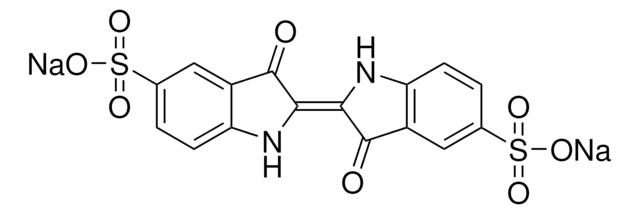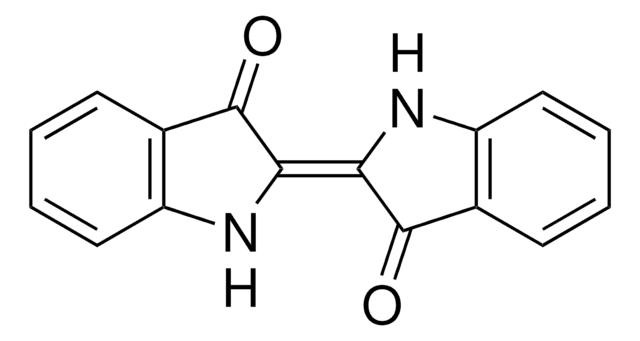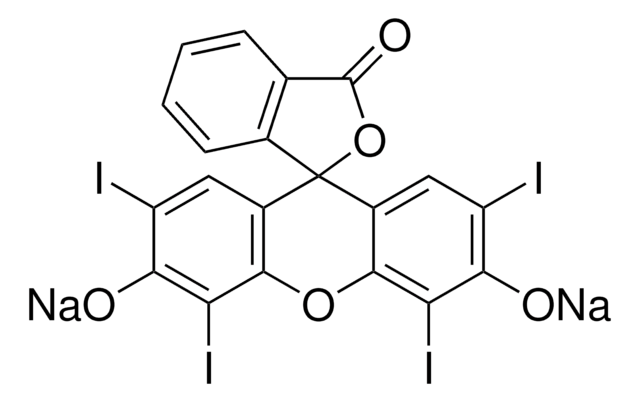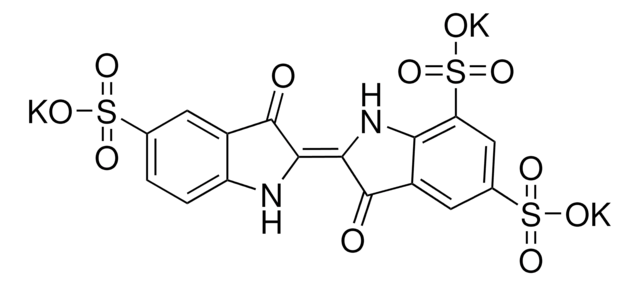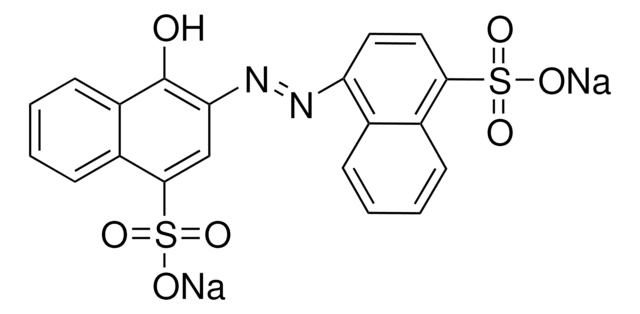131164
Indigo carmine
certified by the BSC, Dye content 85 %
Synonym(s):
Acid Blue 74, Indigo-5,5′-disulfonic acid disodium salt, Indigocarmine
Sign Into View Organizational & Contract Pricing
Select a Size
All Photos(3)
Select a Size
Change View
About This Item
Empirical Formula (Hill Notation):
C16H8N2Na2O8S2
CAS Number:
Molecular Weight:
466.35
Colour Index Number:
73015
Beilstein/REAXYS Number:
4103904
EC Number:
MDL number:
UNSPSC Code:
12171500
PubChem Substance ID:
NACRES:
NA.47
Recommended Products
agency
certified by the BSC
Quality Level
assay
>85.0% (HPLC)
form
solid
composition
Dye content, 85%
color
dark blue to very dark blue
pH
3.87 (30 °C, 7.14 g/L)
mp
≥340 °C
density
0.71 g/cm3 at 29 °C
λmax
608 nm
Looking for similar products? Visit Product Comparison Guide
Application
Indigo carmine has been used to investigate its effects on ozone production by neutrophils.
Biochem/physiol Actions
Indigo Carmine (IC), commonly known as acid blue 74 or food blue 1 or FD and C blue 2 is a blue synthetic dye. It is used as a redox indicator in analytical chemistry and as a microscopic stain in biology. IC is also employed as a photometric detector. IC is a highly toxic indigoid dye and is associated with various health hazards such as irritation to the gastrointestinal tract leading to nausea, vomiting, and diarrhea and irritation in the respiratory tract leading to coughing and shortness of breath. IC exposure might also cause skin and eye irritations to humans. IC dye spray is used for the diagnosis of dysplasia in ulcerative colitis and is considered to be a simple, feasible, and safe method.
Suitability
Used as a collagen stain and in procedures using red nuclear stains.
signalword
Warning
hcodes
Hazard Classifications
Skin Sens. 1
Storage Class
11 - Combustible Solids
wgk_germany
WGK 1
ppe
dust mask type N95 (US), Eyeshields, Gloves
Choose from one of the most recent versions:
Already Own This Product?
Find documentation for the products that you have recently purchased in the Document Library.
Customers Also Viewed
An experimental study of indigo carmine removal from aqueous solution by electrocoagulation
Secula M S
Desalination, 277(1-3), 227-235 (2011)
Pancolonic indigo carmine dye spraying for the detection of dysplasia in ulcerative colitis
Rutter M D
Gut, 53(2), 256-260 (2004)
J. Ind. Chem. Soc., 63, 533-533 (1986)
Superoxide converts indigo carmine to isatin sulfonic acid: implications for the hypothesis that neutrophils produce ozone.
Kettle AJ
The Journal of Biological Chemistry, 279(18), 18521-18525 (2004)
Rice husk ash as an effective adsorbent: evaluation of adsorptive characteristics for Indigo Carmine dye.
Lakshmi UR
Journal of Environmental Management, 90(2), 710-720 (2009)
Our team of scientists has experience in all areas of research including Life Science, Material Science, Chemical Synthesis, Chromatography, Analytical and many others.
Contact Technical Service